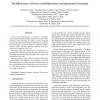IH
2005
Springer
15 years 6 months ago
2005
Springer
Software protection is an area of active research in which a variety of techniques have been developed to address the issue. Examples of such techniques are software watermarking, ...
116
Voted
WCRE
2005
IEEE
15 years 6 months ago
2005
IEEE
In recent years, code obfuscation has attracted attention as a low cost approach to improving software security by making it difficult for attackers to understand the inner worki...
ACSC
2006
IEEE
15 years 6 months ago
2006
IEEE
Code obfuscation is a relatively new technique of software protection and it works by deterring reverse engineering attempts by malicious users of software. The objective of obfus...
121
Voted
ACSAC
2008
IEEE
15 years 7 months ago
2008
IEEE
We propose STILL, a generic defense based on Static Taint and InitiaLization anaLyses, to detect exploit code embedded in data streams/requests targeting at various Internet servi...
101
Voted
IWPC
2009
IEEE
15 years 7 months ago
2009
IEEE
Source code obfuscation is a protection mechanism widely used to limit the possibility of malicious reverse engineering or attack activities on a software system. Although several...

